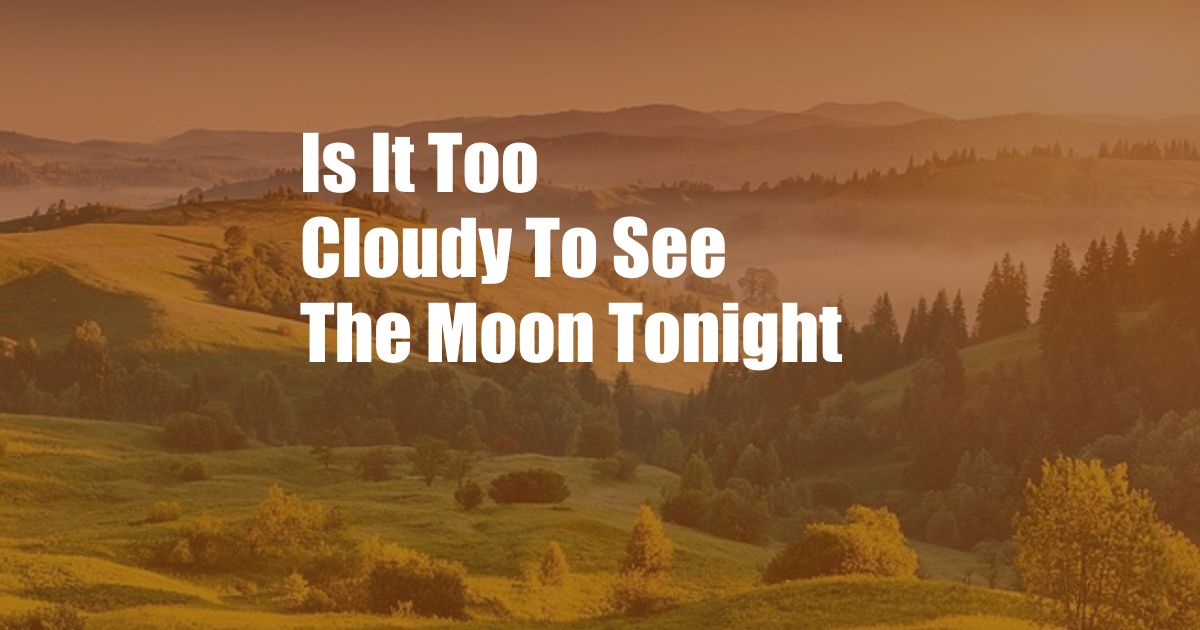
Is It Too Cloudy to See the Moon Tonight
As the sun sets and darkness descends, we often turn our gaze to the night sky. The moon, with its silvery glow, has long captivated our imaginations. But what happens when clouds roll in and obscure our view? Is it still possible to see the moon behind the veil of clouds?
Can Clouds Obscure the Moon?
Clouds can indeed block our view of the moon. Clouds are formed when water vapor in the atmosphere condenses into tiny droplets or ice crystals. These particles can scatter or absorb light, making it difficult for moonlight to reach our eyes.
Types of Clouds and Their Effect on Visibility
Different types of clouds have varying degrees of opacity, which affects how well they can obscure the moon.
- Cirrus clouds: These thin, wispy clouds are composed of ice crystals and allow most moonlight to pass through.
- Cumulus clouds: These puffy clouds are thicker than cirrus clouds and can partially obscure the moon.
- Stratus clouds: These flat, gray clouds can completely block the moon’s light.
- Altocumulus clouds: These mid-level clouds form in layers and can partially or completely hide the moon.
- Nimbostratus clouds: These thick, rain-bearing clouds completely obscure the moon.
Factors Affecting Visibility
In addition to cloud type, several other factors can affect our ability to see the moon through clouds:
- Cloud thickness: The thicker the clouds, the less likely you will be able to see the moon.
- Cloud height: Clouds at higher altitudes are less likely to obscure the moon.
- Moon’s position: If the moon is close to the horizon, clouds can more easily block it because there is more atmosphere to penetrate.
- Light pollution: Bright city lights can make it harder to see the moon, even if the clouds are not thick.
Tips for Seeing the Moon Through Clouds
While clouds can make it challenging to see the moon, there are a few things you can do to improve your chances:
Find a high vantage point: Climb a hill or go to a rooftop to get above the clouds.
Wait for a clear spot: If the clouds are moving, wait for a break in the cloud cover to catch a glimpse of the moon.
Use binoculars or a telescope: These optical devices can help you see through thin clouds.
Enhance the image: Use a moon filter on your camera or smartphone to reduce glare and bring out details.
Observe during the full moon: The full moon is the brightest phase and can be seen even through thin clouds.
Frequently Asked Questions
Q: Can you see the moon during a solar eclipse?
No, during a solar eclipse, the moon passes between the Earth and the sun, blocking the sun’s light. The moon is not visible during a solar eclipse.
Q: Can you see the moon during a lunar eclipse?
Yes, during a lunar eclipse, the Earth passes between the moon and the sun, casting a shadow on the moon. The moon can still be seen, but it appears red or orange due to the Earth’s atmosphere.
Q: Is it harmful to look directly at the moon?
No, it is not harmful to look directly at the moon. However, looking directly at the sun can damage your eyesight.
Conclusion
Whether or not you can see the moon through clouds depends on a variety of factors. By understanding the effects of different cloud types, considering the moon’s position, and using helpful tips, you can increase your chances of enjoying the moon’s glow even on cloudy nights.
Are you interested in learning more about the moon and its influence on our planet? If so, be sure to check out our other articles on this fascinating celestial body.